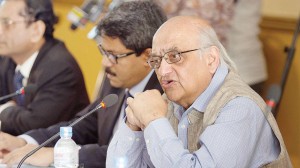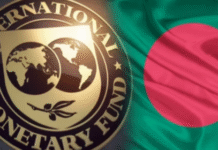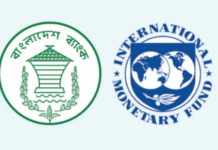Bangladesh has failed to take advantage of the duty-free access to Indian market due to reasons, including lack of leadership, coordination, infrastructure bottlenecks and cumbersome export procedure, trade analysts said yesterday.
To enhance exports to the market, Bangladesh needs to diversify its export basket, they said.
They came up with the observation at a dialogue titled “Utilising Indian Market Access Offer Through Promotion of Trade Facilitation,” organised by Centre for Policy Dialogue (CPD) in Dhaka yesterday, presided over by CPD Chairman Professor Rehman Sobhan. India allowed all but 25 Bangladeshi products duty-free in their market in 2011.
CPD Distinguished Fellow Debapriya Bhattacharya said though volume of trade between the two countries increased over the years, proportionately it declined.
He said infrastructure, lack of port facilities, non-tariff barriers and difficult export procedure are the bottlenecks for increasing trade between the two countries. “But the bottom line is that lack of leadership, initiative and coordination are the stumbling block to boost export to India,” he said.
He said India’s credit was used only to buy truck instead of developing infrastructure, which lacks aims.
State Minister for Foreign Affairs Md Shahriar Alam said to facilitate trade, Bangladesh is negotiating with India to open deputy high commission in Gauhati.
“There is a multi-tier mechanism between Bangladesh and India for enhancement of bilateral trade. The engagement is also intense.”
A very positive development has been there for operationalsing the standard operating procedure signed between the two sides in August 2010, allowing trucks carrying bilateral cargo to cross up to 200 metres beyond the zero line.
As regards port restriction, Indian side maintains that their port restrictions affect very few Bangladesh items.
Abdul Matlub Ahmad, former president of India-Bangladesh Chamber of Commerce and Industry, said the major problem is lack of exportable products. “We need exportable products having quality and competitive price.”
“We invite Indian companies with reputed brand to invest and export back to India, which help reduce the trade gap. We also need to assure industrial plots, gas and electricity to the Indian entrepreneurs.”
Farooq Sobhan, President of Bangladesh Enterprise Institute (BEI) said: “We need to produce new products targeting India.”
Direct flight between Dhaka and Gauhati, trade office, deputy high commission are needed to boost trade, as Bangladeshi products have huge demand in the North-East region of India, he said.
Former commerce secretary Suhel Ahmed Chowdhury said one country is operating two system – one for the North-East region and another for other parts of India.
He said one importer has to go to Kolkata to open LC, which is one of the bottlenecks for increasing export to India.
Former president of the Federation of Bangladesh Chambers of Commerce and Industry (FBCCI) Abdul Awal Mintoo said: “We have still to go a long way. We don’t have enough exportable products, causing yawning trade gap between the two nations.”
He said though infrastructure and non-tariff barriers are the barriers to boost trade, there is also political problem.
CPD Executive Director Professor Mustafizur Rahman in his study report identified four bottlenecks against export increase to India are infrastructure-related bottlenecks, inadequate customs and port facilities, non-tariff barriers and cumbersome export procedures and documentation.
He said Bangladesh’s export to India was only 0.13% of India’s global import while India accounted for 16% of Bangladesh’s total global import.
An interesting feature of Bangladesh’s export to India is that whilst the ratio of Bangladesh’s global export of RMG and non-RMG items was 80:20, in case of India this was the opposite at about 30:70.
This alludes to the potential for Bangladesh’s export diversification in the Indian market, using duty-free access to India.
North-East region of India remain a market with a significant export potential for Bangladesh because of its close proximity to Bangladesh and the high cost of trade transaction with the rest of India.
Source: Dhaka Tribune










